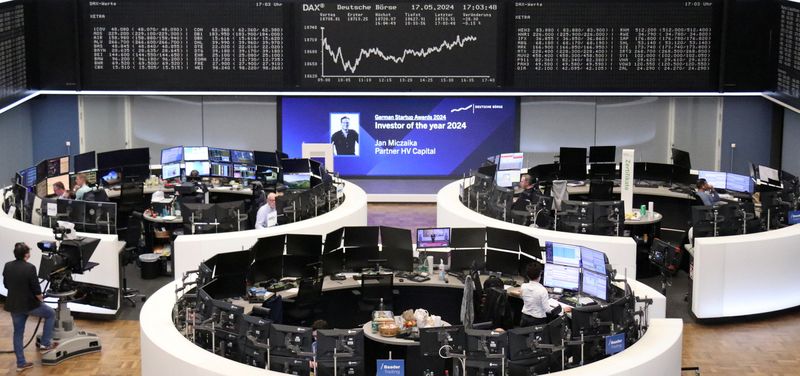Stock investors scout out Europe’s rate-cut winners
2024.06.07 01:10
By Danilo Masoni, Samuel Indyk and Lucy Raitano
MILAN/LONDON (Reuters) – Investors in European equities are stepping up their search for stocks that are likely to benefit from lower borrowing costs, after the European Central Bank’s (ECB) first interest-rate cut in almost five years.
While the cut was expected, analysts see the move as a potential turning point for beaten-down sectors like utilities and small caps, and even highly shorted stocks, which have suffered as rates have risen and stayed high. Banks, which have been some of the biggest beneficiaries of policy tightening, could instead be in for profit-taking.
Much depends on how fast inflation falls toward the central bank’s 2% target, allowing for more cuts in the coming months as the region’s economy recovers.
“Typically, policy easing is supportive for European equities,” said Citi strategist Beata Manthey. “Combined with an inflecting earnings picture, this should help justify some additional upside”.
After Thursday’s quarter-point cut from a record 4%, the ECB’s deposit rate now stands at 3.75%. Central banks in Europe have been first movers in this easing cycle, with Sweden and Switzerland cutting rates in May and March, respectively.
SMALL CAPS TURNING A CORNER
Small caps are seen as one of the most likely winners of rate cuts in Europe. These stocks have lagged their larger counterparts since the ECB began jacking up rates in July 2022.
But now Amundi, Europe’s biggest money manager, and other investors see scope for a rebalancing in their favour.
“As an asset class, small cap has been suffering quite a bit from rates going up everywhere in the world,” said Fabio Di Giansante head of large-cap European equity at Amundi. “Often they are leveraged companies and they need to pay finance while the mid caps and large caps have tons of cash and they can access the debt market quite easily”.
For Goldman Sachs, European small caps represent the “obvious cyclical and rate-sensitive slice of the market which continues to lag the rally”. They have already started to outperform.
Swiss bank UBS suggests going long UK small and mid caps, citing recent tax cuts, upcoming rate cuts and the potential for further fiscal spending and EU alignment as reasons.
RATE-CUT LOVING SECTORS
Utilities and real estate have been two clear losers of a high-rate environment. But some portfolio managers in Europe are positioning for a change in fortune.
Seen as a proxy to bonds because of their extreme sensitivity to rates, utilities might also get a boost out of bets that energy prices have bottomed out and by long-term buying linked to their role in powering the artificial-intelligence and electric-vehicle transitions. Cheap valuations are another plus.
Real estate, which tends to outperform in bond bull markets, might be in for a breather from selling, as the factors that threw some property markets into a deep crisis start to abate. Lower rates might help kick-start new projects, increase asset value and lower the cost of debt.
“Utilities and real estate are the two worst-performing sectors since the beginning of the year in Europe, therefore a reverse trend post rate cuts could be likely,” said Chiara Robba, head of LDI equity at Generali (BIT:) Asset Management.
‘I LOVE TO SQUEEZE THE SHORTS’
Following the revival of the meme frenzy on Wall Street, short-covering risks have come back to the fore.
The big retail ownership of U.S. stocks has little read-across in Europe. But rate cuts across the old continent could give investors a fundamental reason to buy into shorted stocks, especially those where the main issue is debt.
Heavily indebted trainmaker Alstom (EPA:) rose nearly 30% in May in the run-up to setting terms of a 1-billion-euro cash call. Investors are 28% short Alstom — the biggest bearish bet on the STOXX, per data elaborated by Mediobanca (OTC:).
Another top short, BT, rose 17% on earnings day May 16, scoring its biggest surge since going public in 1984. “I always love to squeeze the shorts and prove them wrong ,” its CEO Allison Kirkby said.
Also, lower rates help M&A, making it risky to hold a bearish bet on potential takeover targets, while the growing role of systematic strategies and leveraged hedge funds in setting price action could amplify volatility.
BANK PROFIT-TAKING
European banks have been one of the main beneficiaries of the rise in borrowing costs since 2022, following a decade of low rates and squeezed margins. But strategists are turning cooler on this sector as rates fall.
MSCI’s European banks index is up almost 20% in 2024 alone, the best performing major sector in Europe.
“Banks absolutely love rising bond yields,” said Sebastian Raedler, head of European equity strategy at Bank of America Merrill Lynch (NYSE:).
But if rate cuts lead to lower yields, that tailwind could fade.

“Banks have had good earnings dynamics over the last couple of quarters, predicated on lower risk premiums and higher bond yields,” Raedler added. “If that goes into reverse you should be underweight banks”.
Barclays sees profit-taking in banks around ECB and Bank of England rate cuts in the shorter term, but cheap valuations and buybacks means it is positive on this sector in the longer term.








